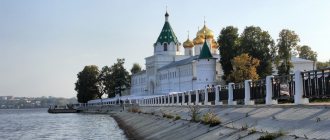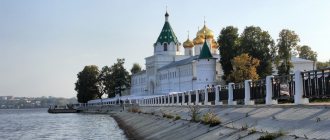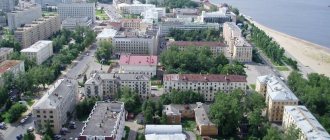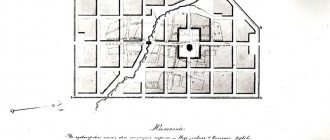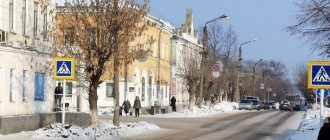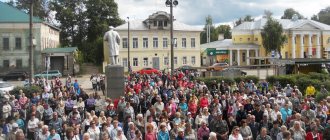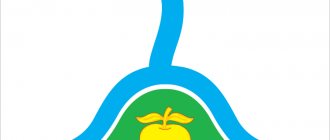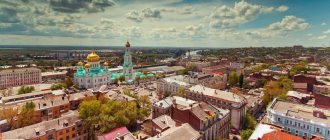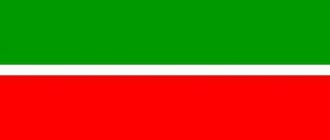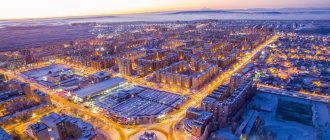Content
- 1 Millionaire cities with more than 1 million people 1.1 Nizhny Novgorod
- 2.1 Dzerzhinsk
- 3.1 Sarov
- 4.1 Navashino
Religious composition
Now let's find out what the population of the Nizhny Novgorod region is like in religious terms.
On the territory of the described subject of the Federation there are quite a few different religious movements. In addition, Nizhny Novgorod is the administrative center of not only the region, but also the Volga Federal District, which, in turn, is the most multi-religious region of the Russian Federation.
The majority of the region's population are Orthodox Christians. Their number currently reaches 76% of all residents of the region. Nizhny Novgorod even has its own metropolis, and the number of parishes in the region reaches 420. In addition, there are fifteen monasteries.
One of the currents of the Orthodox religion is the Old Believers. However, the official church considers this trend sectarian. At the same time, it is the Nizhny Novgorod region that is the cradle of this religious movement. The organizer of his ideology, Archpriest Avvakum, was born here. Therefore, it is natural that it is in this region, in comparison with other subjects of the Federation, that the traditions of the Old Believers remain quite strong. The community of Old Believers is especially large in the Koverninsky district.
Members of other Christian denominations are also present in the region. These are representatives of various Protestant movements: Baptists, Pentecostals, Seventh-day Adventists, Lutherans and other, younger churches. The traditions of Protestantism have been strong in the region since the time of settlement of these places by the Volga Germans. In addition, there is a Catholic parish in Nizhny Novgorod, but it has a rather limited number of parishioners.
There are many Muslims in the Nizhny Novgorod region. There are even more of them than representatives of various Christian movements (naturally, if you do not take into account the Orthodox). This situation is associated with the relatively large number of Tatars and other peoples living in the region, whose national religion is Islam. The Spiritual Administration of Muslims, located in Nizhny Novgorod, is considered the center of Islam in the region.
In addition, there is a Jewish community in the Nizhny Novgorod region. The only synagogue in the region is located in its administrative center - Nizhny Novgorod. At the same time, the total number of Jews in the region is 3.7 thousand people.
There are also residents in the region who profess other religions, but they are not united in communities and do not have official status.
As we can see, the religious diversity in the Nizhny Novgorod region is very diverse.
Millionaire cities with more than 1 million people
Coat of arms of Nizhny Novgorod Flag of Nizhny Novgorod
Nizhny Novgorod
Population 1,266,871 (2016). The largest city on the Volga, the third most populous city in the European part of Russia. In the RSFSR it was the third city in terms of population and industrial potential; its population at its peak reached 1.44 million (1992). After the collapse of the USSR, the city experienced severe depopulation due to the city's proximity to Moscow. The population reached 1 million people in 1962. According to 2011-2013 data, the city ranked 29th to 32nd in the country in terms of industrial production[1].
Among other things, the city is home to the large shipbuilding plant Krasnoye Sormovo, the Nizhny Novgorod Stadium and.
Coat of arms of Dzerzhinsk
Map
| Nizhny Novgorod: maps |
Nizhny Novgorod: photo from space (Google Maps) Nizhny Novgorod: photo from space (Microsoft Virtual Earth)
| Nizhny Novgorod. Nearest cities. Distances in km. on the map (in brackets along roads) + direction. Using the hyperlink in the distance , you can get the route (information courtesy of the AutoTransInfo website) | |||
| 1 | Bor | 5 (26) | NE |
| 2 | Zhdanovsky | 13 () | SE |
| 3 | Bolshoye Kozino | 19 (23) | NW |
| 4 | Kstovo | 22 (32) | SE |
| 5 | Balakhna | 31 (37) | NW |
| 6 | Hydropeat | 33 () | NW |
| 7 | Linda | 33 (47) | WITH |
| 8 | Dzerzhinsk | 35 (35) | Z |
| 9 | Bogorodsk | 38 (49) | SW |
| 10 | Reshetikha | 45 (45) | Z |
| 11 | Gorodets | 48 (53) | NW |
| 12 | Volodarsk | 50 (51) | Z |
| 13 | Trans-Volga region | 50 (60) | NW |
| 14 | Far Konstantinovo | 56 (77) | YU |
| 15 | Vorsma | 58 (69) | SW |
| 16 | Novosmolinsky | 59 () | Z |
| 17 | Semyonov | 61 (86) | NE |
| 18 | Gorbatov | 61 (93) | Z |
| 19 | Ilyinogorsk | 63 (67) | Z |
| 20 | Mulino | 64 () | IN |
| 21 | Chkalovsk | 67 (99) | NW |
| 22 | Pavlovo | 70 (82) | SW |
| 23 | Tumbotino | 70 (89) | SW |
| 24 | Lyskovo | 71 (95) | SE |
| 25 | Bolshoye Murashkino | 76 (94) | SE |
| 26 | Sosnovskoe | 77 (99) | SW |
| 27 | Gorokhovets | 81 (87) | Z |
| 28 | Knyaginino | 84 (111) | SE |
| 29 | Transportation | 86 (126) | SE |
| 30 | In hell | 88 (106) | YU |
a brief description of
Located at the confluence of the Oka and Volga rivers, 439 km east of Moscow. Large railway node: 6 railway lines beams (3 main ones). River port. Metropolitan (since 1985).
The climate is moderate continental. The average temperature in January is about -12C, in July about +18C. Precipitation is 500 mm per year.
25 km from Nizhny Novgorod, within its suburban area, is the balneoclimatic resort area of Green City.
Territory (sq. km): 411
Information about the city of Nizhny Novgorod on the Russian Wikipedia site
Historical sketch
Founded in 1221 by the Vladimir prince Yuri Vsevolodovich as a fortress called Novgorod, which perhaps meant not just “new city”, but repeated the name of the city Novgorod, which is on the Volkhov River.
To distinguish between cities of the same name, the definition lower is introduced, which was first used sporadically, and from the 14th century. almost constantly now. This definition is most often understood as indicating the location of the city in the lower lands, on the Lower Ground. But, according to a number of authors, in this case the city would be called not Nizhny, but Nizovsky Novgorod. In addition, attention is drawn to the fact that pairs of names with the definition lower and upper usually appear within the same river, which is confirmed by many examples, i.e. the city in relation to which Novgorod is lower must be located above it on the Oka or Volga. Such a city could be Gorodets, which arose earlier than Novgorod, lies upstream of the Volga, and it was from it that the functions of an advanced defensive point passed to Novgorod. There is also indirect evidence that Gorodets was originally called the City, and, therefore, it could be contrasted with the New City, also known as the Lower City, hence the name of the inhabitants of Nizhny Novgorod.
Since 1350, the capital of the Nizhny Novgorod-Suzdal principality created in 1341. Thanks to its favorable geographical location, Nizhny Novgorod has acquired the significance of a major trade and cultural center.
Initially, the city was surrounded by oak walls; in 1372, construction of a stone Kremlin began.
In 1392, under Vasily I, Nizhny Novgorod was annexed to the Moscow Principality and soon became a stronghold of Rus' in the fight against the Kazan Khanate. In 1506-11 under Vasily III, a new brick Kremlin was built. The fortress allowed the Nizhny Novgorod residents to repel the raids of the Tatars in 1520 and 1536.
From the second half of the 16th century. one of the largest trade and craft centers of the Moscow State. At this time, two parts of the city took shape: Nagornaya (the center) and Zarechnaya (later the industrial area).
Nizhny Novgorod played an important role in preserving the country during the Time of Troubles. In 1611-12 in Nizhny Novgorod, the militia of the zemstvo elder Kuzma Minin and Prince D.M. was formed. Pozharsky against the Polish interventionists.
In 1708 he was assigned to the Kazan province. In 1714-17 center of the Nizhny Novgorod province, in 1717-19. again in the Kazan province. Since 1719, the center of the newly formed Nizhny Novgorod province. Since 1779, the center of the Nizhny Novgorod governorship (since 1796 - the Nizhny Novgorod province).
In the 19th century, the flour-milling industry and production related to Volga shipping were developed. In 1817, the Makaryevskaya Fair was transferred to Nizhny Novgorod. In 1849, the Sormovo shipbuilding plant was launched. In 1862, Nizhny Novgorod was connected by railway to Moscow.
In 1856, in the provincial city of Nizhny Novgorod, Nizhny Novgorod province, there were 49 churches, 2,555 houses, 550 shops.
From the middle of the 19th century. The Volga shipping company is developing especially intensively.
Since 1929, Nizhny Novgorod has been a regional center. In 1932, it was renamed Gorky in honor of the writer Maxim Gorky (A.M. Peshkov; 1868-1936), a native of this city.
In 1928, the cities of Sormovo (6.3 thousand inhabitants, 1897; city since 1925) and Kanavino (formed in 1925) were included within the boundaries of Nizhny Novgorod.
In 1991, the city returned its historical name.
In 2021, the urban district included 7 settlements of the Bogorodsky municipal district.
Municipal indicators
| Index | 1990 | 1999 | 2001 | 2003 | 2005 |
| Demography | |||||
| Number of births, per 1000 population | 10.7 | 7 | 7.5 | 8.9 | 8.8 |
| Number of deaths, per 1000 population | 11.4 | 14.9 | 16.3 | 18 | 17.5 |
| Natural increase (decrease), per 1000 population | -0.7 | -7.9 | -8.8 | -9.1 | -8.7 |
| Standard of living of the population and social sphere | |||||
| Average monthly nominal accrued wages, rub. | 1193.4 | 2495.2 | 5078.1 | 8078.6 | |
| Average housing area per inhabitant (at the end of the year), sq.m. | 15.6 | 18.4 | 18.9 | 19.8 | 20.3 |
| Number of preschool institutions, pcs. | 513 | 358 | 345 | 334 | 330 |
| Number of children in preschool institutions, thousand people | 82.3 | 44.1 | 43.2 | 43.3 | 44.3 |
| Enrollment of children in preschool educational institutions (at the end of the year), as a percentage of the number of children of the corresponding age, % | 74 | 73.2 | |||
| Number of daytime educational institutions (at the beginning of the school year), pcs. | 178 | 193 | 191 | 196 | 194 |
| Number of students in daytime educational institutions, thousand people | 157.8 | 165.3 | 152.9 | 137.1 | 119.8 |
| Number of doctors, people. | 10289 | 9867 | 9636 | 9637 | 9693 |
| Number of nursing staff, people. | 18883 | 16656 | 15581 | 15469 | 15474 |
| Number of hospital institutions, pcs. | 65 | 72 | 69 | 71 | 70 |
| Number of hospital beds, thousand units | 22.3 | 20.9 | 20 | 18.9 | 19.7 |
| Number of medical outpatient clinics, pcs. | 166 | 183 | 189 | 243 | |
| Capacity of medical outpatient clinics, visits per shift, thousand units. | 27.1 | 25.8 | 29.1 | 29.3 | 30 |
| Number of registered crimes, pcs. | 25952 | 29994 | 28612 | 51409 | |
| Persons who committed crimes were identified, persons. | 13087 | 12492 | 7426 | 8426 | |
| Economy, industry | |||||
| Number of enterprises and organizations (at the end of the year), pcs. | 37103 | 48590 | 108453 | 80374 | |
| Number of operating enterprises by type of activity: mining (at the end of the year), pcs. | 3 | ||||
| Number of operating enterprises by type of activity: manufacturing (at the end of the year), pcs. | 473 | ||||
| Number of operating enterprises by type of activity production and distribution of electricity, gas and water (at the end of the year), pcs. | 116 | ||||
| Volume of shipped goods of own production by type of mining (in actual prices), million rubles. | 16.4 | ||||
| Volume of shipped goods of own production by type of manufacturing (in actual prices), million rubles. | 106518.6 | ||||
| Volume of shipped goods of own production by type of production and distribution of electricity, gas and water (in actual current prices), million rubles. | 22619 | ||||
| Construction | |||||
| Volume of work performed by type of activity “Construction” (until 2004 - volume of work performed under construction contracts), million rubles. | 1461.9 | 3608.5 | 5154.8 | 9348.7 | |
| Commissioning of residential buildings, thousand sq.m. of total area | 500 | 236.1 | 231.3 | 261.3 | 361.7 |
| Commissioning of residential buildings, apartments | 3369 | 2743 | 3459 | 4850 | |
| Commissioning of preschool institutions, places | 2150 | 0 | 0 | 0 | 0 |
| Commissioning of educational institutions, places | 1596 | 0 | 0 | 250 | 525 |
| Commissioning of hospital facilities, beds | 270 | 0 | 0 | 0 | 17 |
| Commissioning of outpatient clinics, visits per shift | 425 | 50 | 0 | 400 | 270 |
| Transport | |||||
| Number of metro stations, pcs. | 13 | 13 | |||
| Operating length of metro tracks, km | 11 | 14 | 15 | ||
| Number of bus routes (in intracity traffic), pcs. | 124 | 190 | 206 | 156 | |
| Number of tram routes, pcs. | 20 | 20 | 21 | 18 | |
| Length of operational tram tracks (at the end of the year), km | 86.5 | 90.2 | 90.2 | ||
| Number of trolleybus routes, pcs. | 20 | 21 | 23 | 23 | |
| Length of operational trolleybus lines (at the end of the year), km | 102.2 | 118.7 | 123.7 | ||
| Number of passengers transported by metro per year, million people. | 60 | 50 | 48.3 | 32.5 | |
| Number of passengers transported by buses per year (in intracity traffic), million people. | 460.5 | 499.6 | 440.5 | 401 | 473 |
| Number of passengers transported by trams per year, million people. | 140.7 | 208.4 | 253.1 | 283.8 | 129 |
| Number of passengers transported by trolleybuses per year, million people. | 64 | 170.8 | 201.1 | 228.1 | 97.9 |
| Connection | |||||
| Number of telephone sets of the city public telephone network, thousand units. | 241.1 | 417.5 | 435.7 | 462.9 | 482.7 |
| Number of residential telephone sets of the city public telephone network, thousand units. | 173.6 | 333 | 358.2 | 388.6 | 402.7 |
| Number of payphones of the city telephone network (including universal ones), pcs. | 2166 | 2456 | |||
| Trade and services to the population | |||||
| Retail trade turnover (in actual prices), million rubles. | 18181.7 | 32782.5 | 61060.7 | 96686.4 | |
| Retail trade turnover (in actual prices), per capita, rub. | 10450 | 24350 | 46568.6 | 74691 | |
| Index of physical volume of retail trade turnover, % compared to the previous year | 111.6 | 110.1 | |||
| Index of physical volume of public catering turnover, % compared to the previous year | 80.5 | 108.8 | |||
| Number of stores, pavilions (at the end of the year), pcs. | 334 | 756 | |||
| Sales area of shops, pavilions (at the end of the year), sq.m. | 88692.5 | 123267.7 | |||
| Volume of paid services to the population (in actual prices), million rubles. | 3935.8 | 7130.7 | 11579.9 | 18486.5 | |
| Volume of paid services to the population (in actual prices), per capita, rub. | 2871 | 5329.4 | 8831.5 | 14281 | |
| Volume of household services to the population (in actual prices), million rubles. | 0.093 | 642.5 | 826.5 | 868.1 | 1336.7 |
| Volume of household services to the population (in actual prices), per capita, rub. | 0.065 | 469 | 618 | 662 | 1032.6 |
| Investments | |||||
| Investments in fixed assets (in actual prices), million rubles. | 1 | 4536.1 | 5124.5 | 9521 | 17063.3 |
| Share of investments in fixed assets financed from budgetary funds in the total volume of investments, % | 8.8 | 19.8 | 18.7 | 14 | |
Data sources:
- Regions of Russia. Main characteristics of the constituent entities of the Russian Federation: statistical collection. Goskomstat of Russia. - M:, 2003.
- Regions of Russia. Basic socio-economic indicators of cities. Statistical collection. Rosstat. - M:, 2005. p. 231
- Transport in Russia: Statistical collection. Goskomstat. - M:, 2003. pp. 110, 112, 114, 120, 122, 123
- Transport in Russia: Statistical collection. Rosstat. - M:, 2005. pp. 117, 119, 121, 127, 129
- Regions of Russia. Basic socio-economic indicators of cities. 2006. Statistical collection. Rosstat. - M:, 2006. p. 235
Culture, science, education
University and technical university. Medical Academy.
Institutes: architectural and construction, pedagogical, water transport engineers, agricultural.
Faculty of Moscow Commercial University. Branches of the All-Russian correspondence institutes: financial and economic, railway engineers. transport.
Conservatory.
Theatres: drama, opera and ballet, young spectators, comedy, puppets.
Museums: Historical and Architectural Museum-Reserve (founded in 1896), art, folk art crafts, architecture and life of the peoples of the Nizhny Novgorod Volga region, river fleet, M. Gorky (with branches “Kashirin’s House” and “M. Gorky’s Last Apartment in Nizhny Novgorod"). House-museums: the Nevzorov sisters, Ya.M. Sverdlova.
Nizhny Novgorod is the birthplace of mechanic I.P. Kulibina, mathematician N.I. Lobachevsky, literary critic N.A. Dobrolyubov, composer M.A. Balakirev, writer P.I. Pechersky.
Architecture, sights
In the 17th century The upland part of the city consisted of the City (i.e. the Kremlin), the surrounding Upper (to the south) and Lower (under the high bank) suburbs and settlements scattered across the neighboring hills.
Architectural monuments of the 16th - early 18th centuries: the Kremlin (fortress walls with towers - 1500, 1508-11) with the Archangel Cathedral (1624-31, L. and A. Vozoulin, on the site of the old 13th century cathedral). Monasteries - Annunciation with the cathedral (1649) and the Assumption Church (1678); Pechersky with the Ascension Cathedral (1632, A. Vozoulin) and 2 tent churches (1642-45 and 1648).
Assumption Church on Ilyinskaya Hill (1672-1715), “Stroganov style” churches - Smolenskaya (1694-97) and Rozhdestvenskaya (1719). Pushnikov's house (17th century).
Since 1770, the Nagorny part of Nizhny Novgorod began to be built up according to a regular plan with buildings in the style of classicism (former Assembly of the Nobility, 1826). Architecture of the late 19th - early 20th centuries: drama theater (1896, architect V.A. Schröter), State Bank (1913, architect V.A. Pokrovsky), Sirotkin House (1913, architects Vesnin brothers; now the Art Museum).
In the 1930s The House of Soviets was built (architect A.Z. Grinberg). In 1964 - circus, river and railway. train stations (1965, reconstruction), air terminal, sports complex, etc.
| Population by year (thousands of inhabitants) | |||||||
| 1811 | 14.4 | 1956 | 876 | 1996 | 1385.9 | 2013 | 1259.9 |
| 1840 | 31.9 | 1959 | 942.0 | 1998 | 1367.7 | 2014 | 1263.9 |
| 1856 | 35.8 | 1962 | 1025 | 2000 | 1357.0 | 2015 | 1267.8 |
| 1863 | 41.5 | 1967 | 1120 | 2001 | 1346.7 | 2016 | 1266.9 |
| 1897 | 90.1 | 1970 | 1170.3 | 2003 | 1311.3 | 2017 | 1261.7 |
| 1913 | 111.4 | 1973 | 1238 | 2005 | 1289.5 | 2018 | 1259.0 |
| 1914 | 111.6 | 1976 | 1305 | 2006 | 1283.6 | 2019 | 1253.5 |
| 1923 | 135.4 | 1979 | 1344.5 | 2007 | 1278.3 | 2020 | 1252.2 |
| 1926 | 217.1 | 1982 | 1373 | 2008 | 1274.7 | 2021 | 1244.3 |
| 1931 | 350.3 | 1986 | 1409 | 2010 | 1271.0 | ||
| 1934 | 463.5 | 1989 | 1438.1 | 2011 | 1250.6 | ||
| 1939 | 643.7 | 1992 | 1440.6 | 2012 | 1254.6 | ||
Medium-sized cities 20-100 thousand people
Sarov
Population 94,417 people (2016). Closed city.
Bor
Population 78,385 (2017). A satellite city of Nizhny Novgorod, located opposite it across the Volga River.
Kstovo
Population 67,305 people (2016).
Pavlovo
Population 58,423 people (2016).
Vyksa
Population 53,477 people (2016).
Balakhna
Population 49,626 people (2016).
Trans-Volga region
Population 38,906 people (2016).
Bogorodsk
Population 34,597 people (2016).
Kulebaki
Population 33,280 people (2016).
Gorodets
Population 30,530 people (2016).
Semyonov
Population 24,583 (2016).
Lyskovo
Population 21,308 people (2016).
Sergach
Population 20,370 people (2016).
Shakhunya
Population 20,217 people (2016).
Small towns up to 20 thousand people
Navashino
Population 15,281 people (2016).
In the city on the banks of the Navashinsky backwater of the Oka River, among other things, the Okskaya Shipyard is located - a manufacturer of small and medium-sized ships, as well as pontoon parks, which is a city-forming enterprise.
Despite formally belonging to another region, Navashino is actually a satellite town of Murom beyond the Oka.
Lukoyanov
Population 14,243 people (2016).
Pervomaisk
Population 13,706 people (2016).
Uren
Population 12,257 people (2016).
Chkalovsk
Population 11,601 people (2016).
Vorsma
Population 10,630 people (2016).
Volodarsk
Population 10,084 people (2016).
Transportation
Population 9,041 people (2016).
Vetluga
Population 8,470 people (2016).
Knyaginino
Population 7,092 people (2016).
Gorbatov
Population 2,004 people (2016).
National composition
Now let's find out the national composition of the region's inhabitants. The population of the Nizhny Novgorod region is quite ethnically diverse. The nationalities that represent the region are quite diverse. But among them the Russians stand out numerically. Currently, their number in the Nizhny Novgorod region is approximately 3110 thousand people, or 93.9% of the population of the entire region. Thus, this nationality has unconditional dominance in this subject of the Federation. This situation has persisted for hundreds of years. It must be said that for the XX-XXI centuries. the percentage of Russians to all residents of the region never fell below 92%.
Among the national minorities inhabiting the Nizhny Novgorod region, Tatars are in first place. This is due to the proximity of the region to the Republic of Tatarstan. The number of Tatars is about 44 thousand people, or 1.33% of the total population. Tatars in terms of number of residents are followed by Mordovians (0.58%), Ukrainians (0.53%), Armenians (0.4%) and Chuvash (0.29%).
Among the population of the Nizhny Novgorod region there are also such exotic nationalities as Koreans and Yezidis, but their number is quite small and does not exceed several thousand people.
see also
- Nizhny Novgorod Region
- Cities of Russia
| [ + ] Cities by regions of Russia | |
| Cities of the North-West (NWFD) | St. Petersburg (and its cities) • Leningrad region (historical Staraya Ladoga) • Arkhangelsk region • Vologda region • Kaliningrad region • Karelia • Komi • Murmansk region • Nenets Autonomous Okrug • Pskov region |
| Cities of the Volga region (Volga Federal District) | Bashkortostan • Volgograd region • Kalmykia • Kirov region • Mari El • Mordovia • Nizhny Novgorod region • Orenburg region • Penza region • Perm region • Samara region • Saratov region • Tatarstan • Udmurtia • Ulyanovsk region • Chuvashia |
| Cities of Southern Russia (SFD) | Sevastopol (including Inkerman) • Republic of Crimea • Adygea • Astrakhan region • Krasnodar region • Rostov region |
| Cities of the North Caucasus (NCFD) | Dagestan • Ingushetia • Kabardino-Balkaria • Karachay-Cherkessia • North Ossetia - Alania • Stavropol Territory • Chechen Republic |
| Cities of the Urals (Ural Federal District) | Kurgan region • Sverdlovsk region • Tyumen region • Khanty-Mansi Autonomous Okrug - Yugra • Chelyabinsk region • Yamalo-Nenets Autonomous Okrug |
| Cities of Siberia (Siberian Federal District) | Altai Republic • Altai Territory • Irkutsk Region • Kemerovo Region • Krasnoyarsk Region • Novgorod Region • Novosibirsk Region • Omsk Region • Tomsk Region • Tyva • Khakassia |
| Cities of the Far East (FEFD) | Amur Region • Buryatia • Jewish Autonomous Region • Trans-Baikal Territory • Kamchatka Territory • Magadan Region • Primorsky Territory • Sakha (Yakutia) • Sakhalin Region • Khabarovsk Territory • Chukotka Autonomous Region |
| see also | Cities of the DPR, LPR, Transnistria, South Ossetia • Regions of Russia • Cities of Russia |
Population density
Density can be calculated by knowing the number of people in the Nizhny Novgorod region and the area of the territory occupied by them.
The area of the region is 76,624 square meters. km. Thus, by simple calculations it can be established that the average population density of the Nizhny Novgorod region is 42.6 people/sq. km. This is the 23rd result out of 85 regions of the country. If we do not take into account the population density in regions whose main territory is cities, then the Nizhny Novgorod region will be in 20th place. For comparison: in the most populated region of the country (Moscow), the population density is 164.9 people/sq. km, and in the most deserted region (Chukchi Autonomous Okrug) – 0.1 people/sq. km.
So the Nizhny Novgorod region looks good in the all-Russian statistics on population density. The area and population of this region are correlated in such a way that the number of people living here is higher than in a significant part of other subjects of the Federation.
